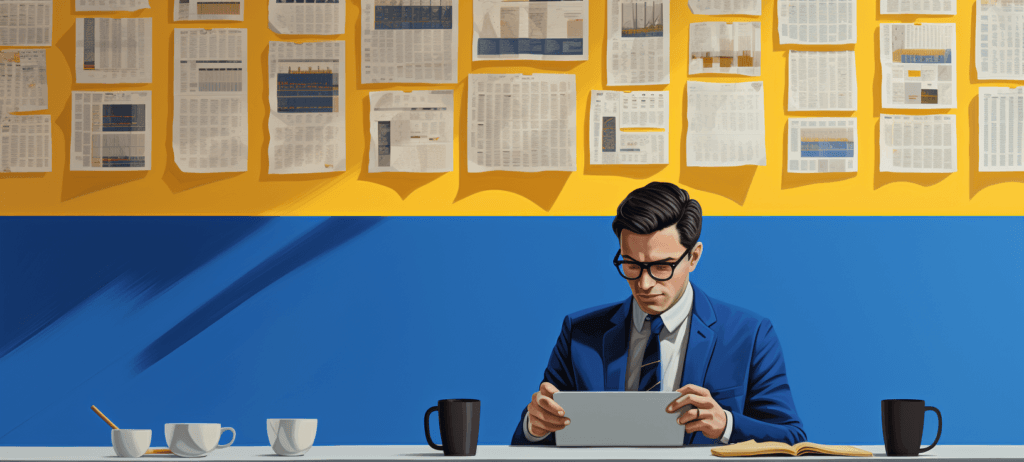-
 14 min. read
14 min. read
-
 Sarah Berry
Sarah Berry Lead Web Marketing Consultant
Lead Web Marketing Consultant
- Sarah Berry is a Lead Web Marketing Consultant at WebFX. With more than 10,000 hours of experience, she offers practical insights and strategies you can use to grow your digital revenue. When she isn’t polishing her Time Magazine Person of the Year Award, she’s spending time with her flock of ducks.
Almost 60% of people credit email for influencing their purchase decisions, which makes sense since the average person spends up to 60 minutes every week checking their inbox for offers, updates, and the status of their latest purchase. If you want to turn email into a powerhouse marketing channel for your business, you need to learn how to create emails for every stage of the buyer’s journey, from awareness to consideration to purchase. Once you do, you can start generating even more revenue from email marketing.
Keep reading to learn how to create emails for your buyer journey! This post includes an overview of the four stages of the buyer’s journey in email marketing, plus tips and examples for how to optimize your emails for every step.
P.S. Get more tips and tricks for email marketing, as well as other marketing channels, with our newsletter, Revenue Weekly, which more than 200,000 other marketers trust for keeping their strategy ahead of the game. Sign up today to receive your first batch of helpful tips and tricks!
What are the 4 stages of the buyer’s journey in email marketing?
The four stages of the buyer’s journey in email marketing include:
- Awareness
- Consideration
- Purchase
- Loyalty
Skip ahead: Already know about the different stages of the customer journey? Skip ahead to our tips!
1. Awareness
The awareness stage focuses on top-of-the-funnel subscribers. These subscribers are almost always new to your brand. They’ve only recently heard of your products, services, or company, but you offered something that motivated them enough to become a subscriber, like a free guide or promotion.
Some common challenges or questions of the awareness stage include:
- Why should they continue to subscribe to your emails?
- What value do they get from your emails?
- How can you help them?
- Why should they even consider or trust your business for their problems?
For most companies, the awareness stage is tricky because you need to nurture subscribers. If you try to force a subscriber to the next step, they’ll often unsubscribe and have a less-than-positive first impression of your company, which can translate to negative mentions of your brand online and offline.
2. Consideration
The consideration stage focuses on middle- and bottom-of-the-funnel subscribers. This stage can feature new and existing subscribers. If your company offers product demos, for example, you may place all the users who sign-up for a product demo into email drip campaigns for the consideration, versus the awareness stage because of the user intent.
The person understands what you offer, so much that they requested a demo. In the consideration stage, you have a few challenges or questions to answer:
- Why should they continue to subscribe to your emails?
- What value do they get from your emails?
- How is your company’s products or services different from the competition?
- What makes your business unique, both as a brand and provider of products or services?
How you position your company, products, and services is critical during the consideration stage. You want to create a balance between providing educational content and transactional content because that offers subscribers the most value. Focus too much on driving a sale, and you’ll lose one instead.
3. Purchase
The purchase stage focuses on bottom-of-the-funnel subscribers. These subscribers are ready to make a move — it’s up to you to make the offer. With a compelling enough offer, as well as an understanding of your subscriber, you can motivate them to contact your company, purchase your product, and more.
In the purchase stage, you’ll consider these challenges or questions:
- Why should they continue to subscribe to your emails?
- What value do they get from your emails?
- What is unique and valuable about your offer?
- What are the terms of your offer, like when do they need to act?
- How will your company, products, or services change their life?
Notice that you’ll continually have to answer the same questions throughout the email marketing buyer journey. You’ll always have to provide enough value to keep people subscribed and engaged with your emails, for example, as well as include reminders for the unique benefits of your offerings.
4. Loyalty
The loyalty stage focuses on your customers. These customers may include past subscribers that you nurtured through your email drip campaigns or brand-new customers that purchased your products or services without ever entering your email marketing campaigns. This stage is a critical part of the customer journey because it allows your business to:
- Limit customer turnover, or loss of clients
- Drive repeat purchases
- Build brand loyalty
It’s also essential because if you want customers to become an advocate of your brand, they have to become loyal first. Having brand advocates is immensely valuable because people trust other people for recommendations. In the loyalty stage, your challenges (or questions to answer) include:
- Why should they continue to subscribe to your emails?
- What value do they get from your emails?
- How will you reward them for their loyalty?
- What unique, personalized offers do you have for them?
- Why should they recommend your brand to others?
- What will they receive in return for recommending your brand?
The loyalty stage is an excellent opportunity for your company to earn more and learn more. You can use what you know about a subscriber, like their purchase habits, for example, to deliver personalized recommendations to drive even more sales.
How to create emails for every stage of the buyer’s journey in email marketing
Are you ready to learn how to create emails for every stage of the buyer’s journey? Keep reading for tips, plus see customer journey email examples to get ideas for your email campaigns!
All stages
Every stage in the buyer’s journey in email marketing emphasizes the importance of offering value.
You need to offer value to keep people subscribed and engaged with your email content. If you lose them at any point, you decrease their chances of becoming a loyal customer. The following tips can help you meet user expectations across stages:
- Set up segmented drip campaigns: With drip campaigns, you can create automated journeys for different segments of your audience, like those in the awareness, consideration, or purchase stage. You can easily create segments and automated journeys with a tool like EmailMarketingFX.
- Create a single goal for every email: All your emails should have a goal, whether it’s for users to check out a shared article or linked product. Setting a goal gives your email structure and can help you achieve the results you want because you know what you want.
- Ensure every email provides value: Sharing email drafts with test audiences, like friends and family, can help you send great emails. Ask for their opinion on the email’s subject line, content, offer, and more. Find out if they would open, read, and act on that email — and why.
- Limit the length of your emails: Long-form content may work well for search engine optimization (SEO), but email marketing isn’t SEO. That’s why it’s essential to keep your emails shorter versus longer. Aim for around 200 words, if possible.
Apply these tips across your email marketing strategy to maximize your email marketing ROI!
Awareness
In the awareness stage of the buyer’s journey in email marketing, you can get the most value by:
- Sharing information resources: Education is the basis for the awareness stage. In almost all cases, your subscribers want to learn more. You can help them learn more by sharing relevant resources from your site, like a blog post or articles from related, non-competitor sites.
- Limiting mentions of products or services: While you do want to make people aware of what you offer, you want to keep those mentions at a minimum. If you talk about yourself all the time, people aren’t going to stick around to listen.
- Highlighting tools, templates, quizzes, and more: Interactive resources are an excellent way to provide value while also educating users. If you have tools, like a calculator, for example, they can help your subscribers while also highlighting your business.
As an example, check out this email newsletter from Thorne, a multi-vitamin and dietary supplement researcher and manufacturer that collaborates with the Mayo Clinic, as well as several other respected organizations. 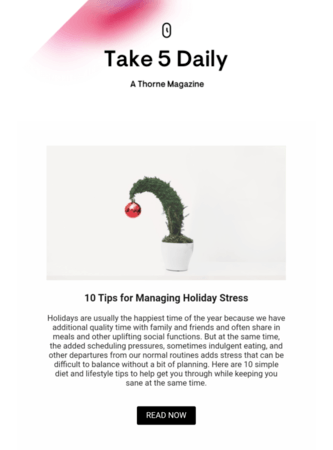 This email newsletter, called “Take 5 Daily,” highlights a few different articles from the company’s blog, like how to manage holiday stress. All the articles focus on health, which aligns with Thorne’s focus and likely the focus of their subscribers.
This email newsletter, called “Take 5 Daily,” highlights a few different articles from the company’s blog, like how to manage holiday stress. All the articles focus on health, which aligns with Thorne’s focus and likely the focus of their subscribers.
If you view the articles, Thorne does occasionally mention its products, when appropriate.  The company also cites studies from respected organizations and medical professionals, like the Mayo Clinic, which makes sense when considering consumer concerns when shopping for dietary supplements, which the Food and Drug Administration (FDA) doesn’t regulate.
The company also cites studies from respected organizations and medical professionals, like the Mayo Clinic, which makes sense when considering consumer concerns when shopping for dietary supplements, which the Food and Drug Administration (FDA) doesn’t regulate.
What can you learn from this customer journey email example? Understand the “why” behind someone finding your site and becoming a subscriber.
For example, maybe they wanted to improve their health. Then, use that understanding to share relevant, helpful, and trustworthy content.
Consideration
You can help your emails succeed with subscribers in the consideration stage by:
- Including a distinct call-to-action (CTA): While all emails should include a CTA, it’s critical for emails in the consideration stage to have one, like for reading a specific article, downloading a template, or exploring a product’s features. You can use a button to emphasize your CTA.
- Adding trust signals: Testimonials, case studies, product reviews, awards, and certifications all serve as valuable trust signals. Incorporate these signals into your email body, for example, or give them a permanent place in your email header or footer.
- Continuing to share educational content: Guides, webinars, podcasts, blog posts, and more can all share information your audience finds helpful. Based on subscriber opens and clicks, you may have the chance to tailor your content to their unique interests, like hiking versus running.
As an example, look at another email from Thorne: 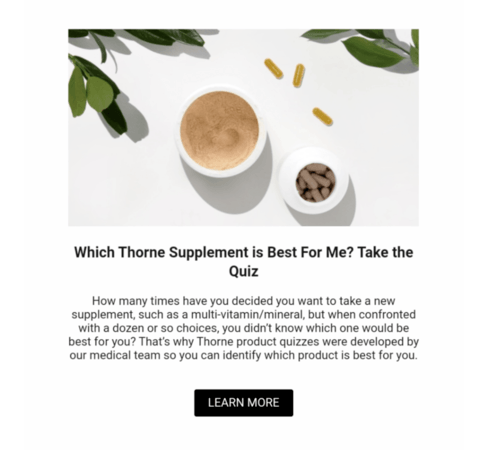 In this email from Thorne’s “Take 5 Daily” newsletter, the company includes an offer for subscribers to take a quiz. This quiz will share which of the company’s supplements is right for the reader, which can move them from awareness to consideration to purchase in one step. Notice Thorne includes a clear CTA: “Learn More.” Thorne also addresses some of the pain points that shoppers have when looking for supplements.
In this email from Thorne’s “Take 5 Daily” newsletter, the company includes an offer for subscribers to take a quiz. This quiz will share which of the company’s supplements is right for the reader, which can move them from awareness to consideration to purchase in one step. Notice Thorne includes a clear CTA: “Learn More.” Thorne also addresses some of the pain points that shoppers have when looking for supplements.
They don’t know which ones are right for them. Thorne’s quiz, though, will help them find the perfect ones — and make the process fun. 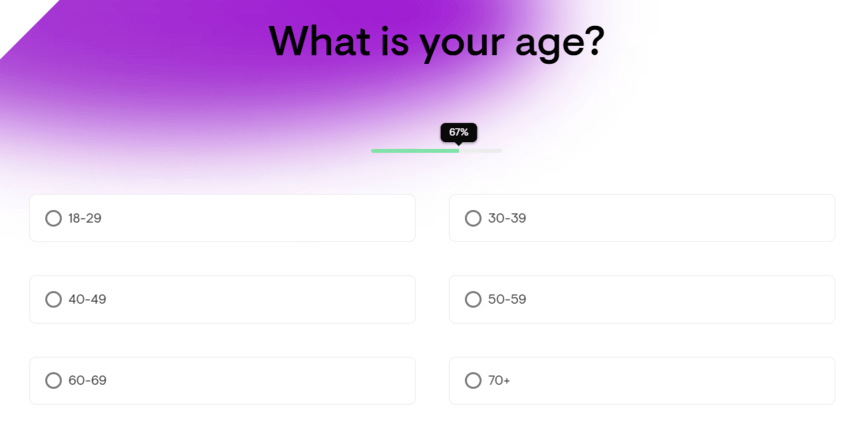
What can you learn from this customer journey email example?
Interactive content that solves a common user problem, combined with a distinct CTA, is a smart way to move users from one stage of the email marketing buyer journey to the next.
Purchase
In the purchase stage, you can get the best results by following these tips:
- Have a compelling offer: Without a compelling offer, you’ll struggle to turn a subscriber into a customer. Think about your subscribers. What holds them back from purchasing your product or contacting your company?
Use your answer to create your offer — and highlight it with a CTA.
- Make the offer stand out: If you want people to act, you need to put your offer front-and-center. Besides citing your offer in the text, for instance, create an image or GIF to draw a person’s eye to your offer.
- Provide something for free: Free is a powerful word. That’s why many offers will provide something for free, whether it’s free shipping, free estimates, or free company swag. Your free offer, though, will need to get your audience excited enough to act.
- Set an offer deadline: With an expiration date, your business can drive users to act. If you’re only providing free shipping through the weekend, for example, that can motivate someone to purchase this Friday versus making a mental reminder to claim that offer later.
As an example, check out this promotional email from Thorne, which coincided with Cyber Monday. 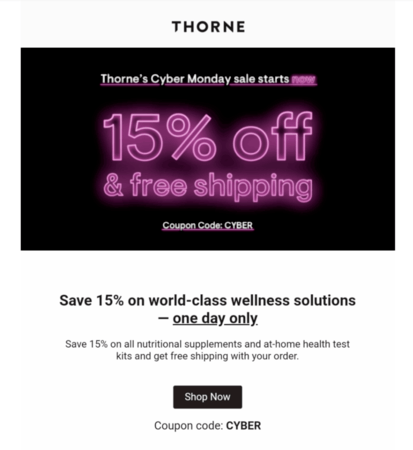 The company quickly highlights its offer: 15% off (with the code CYBER) and free shipping. Readers also get immediate answers to common questions about promotions:
The company quickly highlights its offer: 15% off (with the code CYBER) and free shipping. Readers also get immediate answers to common questions about promotions:
- What is the offer?
- How long does the promotion last?
- What products or services can use the promotion?
- How do I apply the offer?
- Where can I go to take advantage of this offer?
Thorne also highlights what users will get when purchasing from Thorne: World-class wellness solutions.
What can you learn from this customer journey email example? Besides making a compelling offer, your offer should stand out. Your email should also answer questions that often hold people back from action, like the offer’s deadline, application, and more.
Loyalty
In the loyalty stage, you can apply the following tips to maximize the ROI of email marketing:
- Offer personalized product or service recommendations: Companies like Amazon do exceedingly well by providing customized recommendations to shoppers. If your business offers more than one product or service, you can take this approach too.
- Create a loyalty reward or referral program: Building a loyalty reward or referral program takes time, but it can drive repeat purchases and word-of-mouth recommendations. Blue Apron used a referral program with massive success — the program generated 34% of its new clients.
- Provide tips and tricks related to your products or services: Once someone buys (or subscribes to) your product or services, you need to make sure they love it. A software company, for example, may regularly provide tips, tricks, or advice on how to use their program.
- Share company updates: Establishing customer loyalty goes beyond people loving your product — people need to like your brand too. Sending company updates, say every quarter, can help remind readers why they chose your business and reinforce their loyalty.
As an example, here is another email from Thorne: 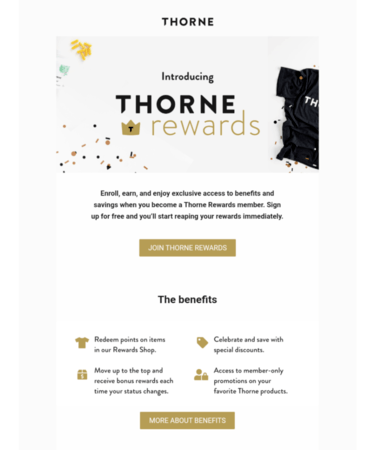 This email highlights the launch of the company’s rewards program, Thorne Rewards. It includes a few CTAs, like “Join Thorne Rewards” and “More About Benefits,” which all aim to achieve the same goal: Get the subscriber to create an account and join Thorne Rewards. The email also provides a quick rundown of how users will benefit, like by receiving exclusive discounts.
This email highlights the launch of the company’s rewards program, Thorne Rewards. It includes a few CTAs, like “Join Thorne Rewards” and “More About Benefits,” which all aim to achieve the same goal: Get the subscriber to create an account and join Thorne Rewards. The email also provides a quick rundown of how users will benefit, like by receiving exclusive discounts.
What can you learn from this customer journey email example? This email example provides an excellent summary of why someone would want to sign up for Thorne Rewards.
They can save money, redeem points, and more. Plus, they have quick and easy links, via buttons, for more information.
Optimize your email marketing funnel for revenue
Now that you know how to create emails for every stage of the buyer’s journey, are you ready to get started? If it feels overwhelming, it’s normal.
The four stages of the buyer’s journey in email marketing all come with unique challenges. The good news, however, is that email marketing provides fast feedback. When you send an email, you can quickly view the data to understand how people interacted with your content, offers, and more.
Then, you can use that information to revise your campaigns and optimize them for success. If you need help with building and optimizing your email marketing campaign, though, WebFX can help. Check out our email marketing management plans, and learn how our award-winning team of more than 500 digital marketing specialists can help your business turn email marketing into a revenue-driving channel!
-
 Sarah Berry is a Lead Web Marketing Consultant at WebFX. With more than 10,000 hours of experience, she offers practical insights and strategies you can use to grow your digital revenue. When she isn’t polishing her Time Magazine Person of the Year Award, she’s spending time with her flock of ducks.
Sarah Berry is a Lead Web Marketing Consultant at WebFX. With more than 10,000 hours of experience, she offers practical insights and strategies you can use to grow your digital revenue. When she isn’t polishing her Time Magazine Person of the Year Award, she’s spending time with her flock of ducks. -

WebFX is a full-service marketing agency with 1,100+ client reviews and a 4.9-star rating on Clutch! Find out how our expert team and revenue-accelerating tech can drive results for you! Learn more
Try our free Marketing Calculator
Craft a tailored online marketing strategy! Utilize our free Internet marketing calculator for a custom plan based on your location, reach, timeframe, and budget.
Plan Your Marketing Budget

Proven Marketing Strategies

Proven Marketing Strategies
Try our free Marketing Calculator
Craft a tailored online marketing strategy! Utilize our free Internet marketing calculator for a custom plan based on your location, reach, timeframe, and budget.
Plan Your Marketing Budget
What to read next

